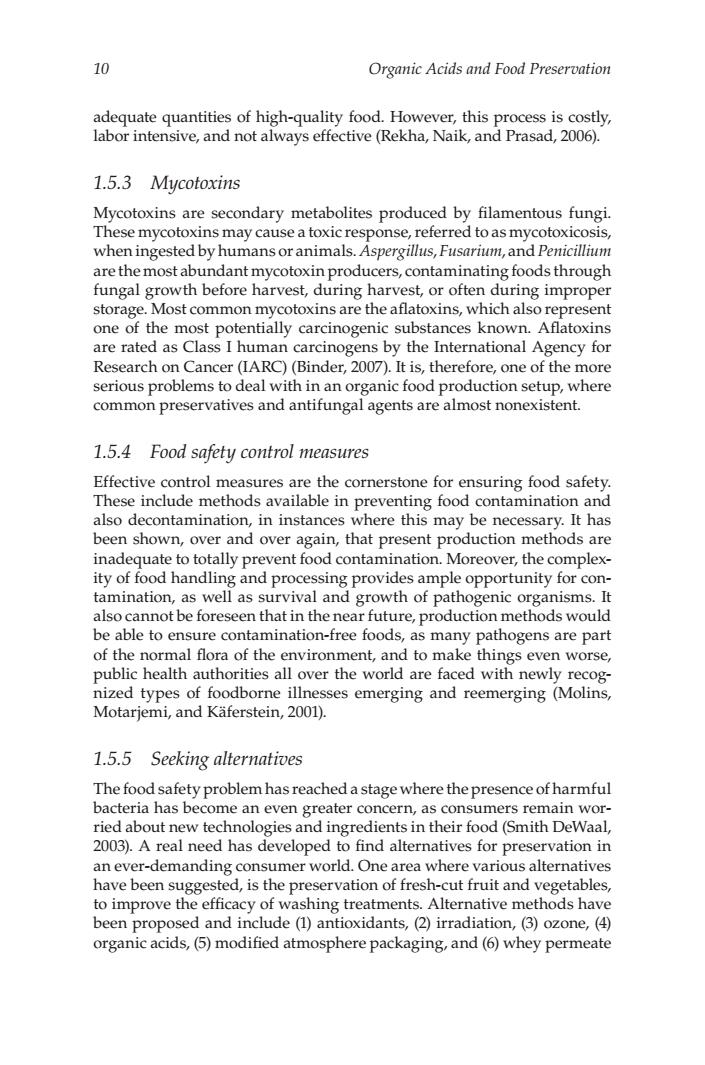正在加载图片...

0 Organic Acids and Food Preservation quantities of high-quality food.Howe this (Rekha,Nak,and) ce ss is costly 1.5.3 Mycotoxins Mycotoxins are secondary metabolites produced by filamentous fungi. These mycotoxins may cause a toxic response,referred to as mycotoxicosis, wheningested by humansor animals.Aspergillus,Fusarium,and Penicillium are ther contaminating foods through th before harvest,during h ng imprope storag hich also represen one of the most potentially carcinogenic substances known.Aflatoxins are rated as Class I human carcinogens by the International Agency for Research on Cancer (IARC)(Binder,2007).It is,therefore,one of the more serious problems to deal with in an organic food production setup,where common preservatives and antifungal agents are almost nonexistent. 1.5.4 Food safety control measures Effective control measures are the cornerstone for ensuring food safety These include methods available in preventing food contamination and also decontamination,in instances where this may be necessary.It has been shown,over and over again,that present production methods are inadequate to totally prevent food contamination.Moreover,the complex- ity of food handling and processing provides ample opp ortunity for con- tamination as well as su vival and rowth of p nic orga nisms It also c th re,productio would re cor as ma ny pathogens are par of the normal flora of the environment,and to make things even worse, public health authorities all over the world are faced with newly recog- nized types of foodborne illnesses emerging and reemerging(Molins, Motarjemi,and Kaferstein,2001). 1.5.5 Seeking alternatives The food safety problem has reached a stage where the presence of harmful ia has e an even greater concern,as c ried about new technologies and ingredients in their food(Smith DeWaal 2003).A real need has developed to find alternatives for preservation in an ever-demanding consumer world.One area where various alternatives have been suggested,is the preservation of fresh-cut fruit and vegetables, to improve the efficacy of washing treatments.Alternative methods have been proposed and include (1)antioxidants,(2)irradiation,(3)ozone,(4) organic acids. (5)modified atmosphere packaging,and(6)whey permeat10 Organic Acids and Food Preservation adequate quantities of high-quality food. However, this process is costly, labor intensive, and not always effective (Rekha, Naik, and Prasad, 2006). 1.5.3 Mycotoxins Mycotoxins are secondary metabolites produced by filamentous fungi. These mycotoxins may cause a toxic response, referred to as mycotoxicosis, when ingested by humans or animals. Aspergillus, Fusarium, and Penicillium are the most abundant mycotoxin producers, contaminating foods through fungal growth before harvest, during harvest, or often during improper storage. Most common mycotoxins are the aflatoxins, which also represent one of the most potentially carcinogenic substances known. Aflatoxins are rated as Class I human carcinogens by the International Agency for Research on Cancer (IARC) (Binder, 2007). It is, therefore, one of the more serious problems to deal with in an organic food production setup, where common preservatives and antifungal agents are almost nonexistent. 1.5.4 Food safety control measures Effective control measures are the cornerstone for ensuring food safety. These include methods available in preventing food contamination and also decontamination, in instances where this may be necessary. It has been shown, over and over again, that present production methods are inadequate to totally prevent food contamination. Moreover, the complexity of food handling and processing provides ample opportunity for contamination, as well as survival and growth of pathogenic organisms. It also cannot be foreseen that in the near future, production methods would be able to ensure contamination-free foods, as many pathogens are part of the normal flora of the environment, and to make things even worse, public health authorities all over the world are faced with newly recognized types of foodborne illnesses emerging and reemerging (Molins, Motarjemi, and Käferstein, 2001). 1.5.5 Seeking alternatives The food safety problem has reached a stage where the presence of harmful bacteria has become an even greater concern, as consumers remain worried about new technologies and ingredients in their food (Smith DeWaal, 2003). A real need has developed to find alternatives for preservation in an ever-demanding consumer world. One area where various alternatives have been suggested, is the preservation of fresh-cut fruit and vegetables, to improve the efficacy of washing treatments. Alternative methods have been proposed and include (1) antioxidants, (2) irradiation, (3) ozone, (4) organic acids, (5) modified atmosphere packaging, and (6) whey permeate